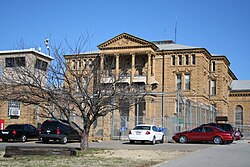
Joliet Correctional Center was a prison in Joliet, Illinois, United States, from 1858 to 2002. It is featured in the motion picture The Blues Brothers as the prison from which Jake Blues is released at the beginning of the movie. It is also used for the exterior shots of the Illinois "state prison" in the James Cagney film White Heat, and the location for first season of Fox Network's Prison Break television show, and the movie Let's Go to Prison. In 2018, it opened for tours.
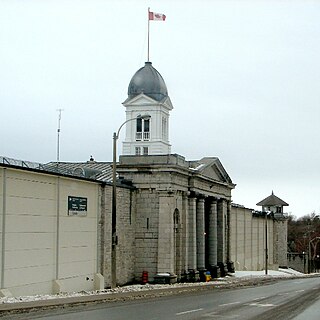
Kingston Penitentiary is a former maximum security prison located in Kingston, Ontario, Canada, between King Street West and Lake Ontario.

Attica Correctional Facility is a maximum security campus New York State prison in the town of Attica, New York, operated by the New York State Department of Corrections and Community Supervision. It was constructed in the 1930s in response to earlier riots within the New York state prisons.
The Iowa State Penitentiary (ISP) is an Iowa Department of Corrections maximum security prison for men located in the Lee County, Iowa, community of Fort Madison. This facility should not be confused with the Historical Iowa State Penitentiary, which was shut down in 2015 after being open for 175 years. The HISP itself was a 550-person maximum security unit. Also on the complex was a John Bennett Correctional Center - a 169-person medium security unit. The HISP included two minimum-security farms with about 170 people who were located within a few miles of the main complex. The complex also had a ten-person multiple care unit, and a 120-bed special-needs unit for prisoners with mental illness or other diseases that require special medical care. In total, there were about 950 inmates and 510 staff members.
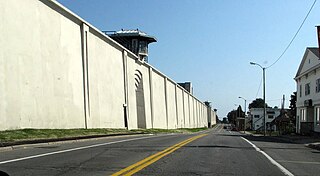
Clinton Correctional Facility is a New York State Department of Corrections and Community Supervision maximum security state prison for men located in the Village of Dannemora, New York. The prison is sometimes colloquially referred to as Dannemora, although its name is derived from its location in Clinton County, New York. The southern perimeter wall of the prison borders New York State Route 374. Church of St. Dismas, the Good Thief, a church built by inmates, is located within the walls. The prison is sometimes referred to as New York's Little Siberia, due to the cold winters in Dannemora and the isolation of the upstate area. It is the largest maximum-security prison and the third-oldest prison in New York. The staff includes about 1,000 officers and supervisors.
Auburn Correctional Facility is a state prison on State Street in Auburn, New York, United States. It was built on land that was once a Cayuga village. It is classified as a maximum security facility.

The New Jersey State Prison (NJSP), formerly known as Trenton State Prison, is a state men's prison in Trenton, New Jersey operated by the New Jersey Department of Corrections. It is the oldest prison in New Jersey and one of the oldest correctional facilities in the United States. It is the state's only completely maximum security institution, housing the most difficult and/or dangerous male offenders in the inmate population. NJSP operates two security units and provides a high level of custodial supervision and control. Professional treatment services, such as education and social work, are a priority at the facility. The Bureau of State Use Industries operated the bedding and clothing shops that were once located in Shop Hall at the facility. These industries have been relocated to South Woods State Prison.
Pontiac Correctional Center, established in June 1871, is an Illinois Department of Corrections maximum security prison for adult males in Pontiac, Illinois. The prison also has a medium security unit that houses medium to minimum security inmates and is classified as Level 3. Until the 2011 abolition of the death penalty in Illinois, the prison housed male death row inmates, but had no execution chamber. Inmates were executed at the Tamms Correctional Center. Although the capacity of the prison is 2172, it has an average daily population of approximately 2000 inmates.

Oregon State Penitentiary (OSP), also known as Oregon State Prison, is a maximum security prison in the northwest United States in Salem, Oregon. Originally opened in Portland 173 years ago in 1851, it relocated to Salem fifteen years later. The 2,242-capacity prison is the oldest in the state; the all-male facility is operated by the Oregon Department of Corrections (ODOC). OSP contains an intensive management wing, which is being transformed into a psychiatric facility for mentally ill prisoners throughout Oregon.

Stateville Correctional Center (SCC) is a maximum security state prison for men in Crest Hill, Illinois, United States, near Chicago. It is a part of the Illinois Department of Corrections.

Thomas Edward Silverstein was an American criminal who spent the last 42 years of his life in prison after being convicted of four separate murders while imprisoned for armed robbery, one of which was overturned. Silverstein spent the last 36 years of his life in solitary confinement for killing corrections officer Merle Clutts at the Marion Penitentiary in Illinois. Prison authorities described him as a brutal killer and a former leader of the Aryan Brotherhood prison gang. Silverstein maintained that the dehumanizing conditions inside the prison system contributed to the three murders he committed. He was held "in a specially designed cell" in what is called "Range 13" at ADX Florence federal penitentiary in Colorado. He was the longest-held prisoner in solitary confinement within the Bureau of Prisons at the time of his death. Correctional officers refused to talk to Silverstein out of respect for Clutts.
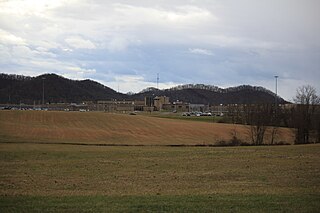
The Southern Ohio Correctional Facility is a maximum security prison located just outside Lucasville in Scioto County, Ohio. The prison was constructed in 1972. As of 2022, the warden is Donald Redwood.

The Oklahoma State Penitentiary, nicknamed "Big Mac", is a prison of the Oklahoma Department of Corrections located in McAlester, Oklahoma, on 1,556 acres (6.30 km2). Opened in 1908 with 50 inmates in makeshift facilities, today the prison holds more than 750 male offenders, the vast majority of which are maximum-security inmates. They also hold many death row prisoners.

The Maryland Metropolitan Transition Center (MTC), formerly known as the historic "Maryland Penitentiary", is a maximum pre-trial security Maryland Department of Public Safety and Correctional Services prison located in Baltimore facing Greenmount Avenue between Forrest Street and East Madison Street. It was established in 1811 as the first prison in the state and the second of its kind in the country and the original buildings faced towards East Madison Street above the east bank of the Jones Falls stream and adjacent to the old stone walls of the Baltimore City Jail, earlier established in 1801, rebuilt in 1857–1859, and later in 1959–1965.

The Union Correctional Institution, formerly referred to as Florida State Prison, Raiford Prison and State Prison Farm is a Florida Department of Corrections state prison located in unincorporated Union County, Florida, near Raiford.

The Montana State Prison is a men's correctional facility of the Montana Department of Corrections in unincorporated Powell County, Montana, about 3.5 miles (5.6 km) west of Deer Lodge. The current facility was constructed between 1974 and 1979 in response to the continued degeneration of the original facility located in downtown Deer Lodge.
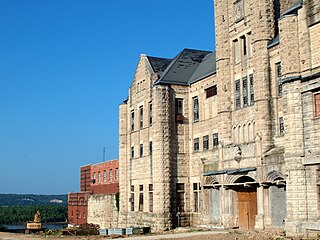
The Missouri State Penitentiary was a prison in Jefferson City, Missouri, that operated from 1836 to 2004. Part of the Missouri Department of Corrections, it served as the state of Missouri's primary maximum security institution. Before it closed, it was the oldest operating penal facility west of the Mississippi River. It was replaced by the Jefferson City Correctional Center, which opened on September 15, 2004.

The South Dakota State Penitentiary is a state prison located in South Dakota's largest city, Sioux Falls. The building's industry shop makes several things for the state, including woodwork and license plates. The State Penitentiary also houses South Dakota's death row for men and the state's execution chamber.

The State Correctional Institution (SCI) at Camp Hill, commonly referred to as SCI Camp Hill, is a Pennsylvania Department of Corrections prison in Lower Allen Township, Cumberland County, near Camp Hill in Greater Harrisburg. Its current superintendent is Laurel Harry. It has around 3,400 inmates.

The South Carolina Penitentiary was the state of South Carolina's first prison. Completed in 1867, the South Carolina Penitentiary served as the primary state prison for nearly 130 years until its demolition in 1999. It was located adjacent to the Congaree River in Columbia, South Carolina and was added to the National Register of Historic Places on January 4, 1996. It was replaced by the Lee Correctional Institution as the main prison in the state of South Carolina after the prison was deemed too overcrowded by a federal court.
